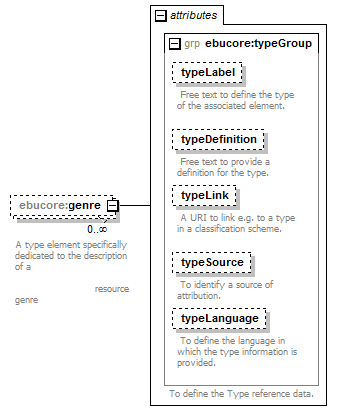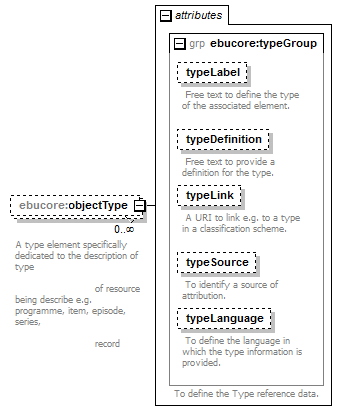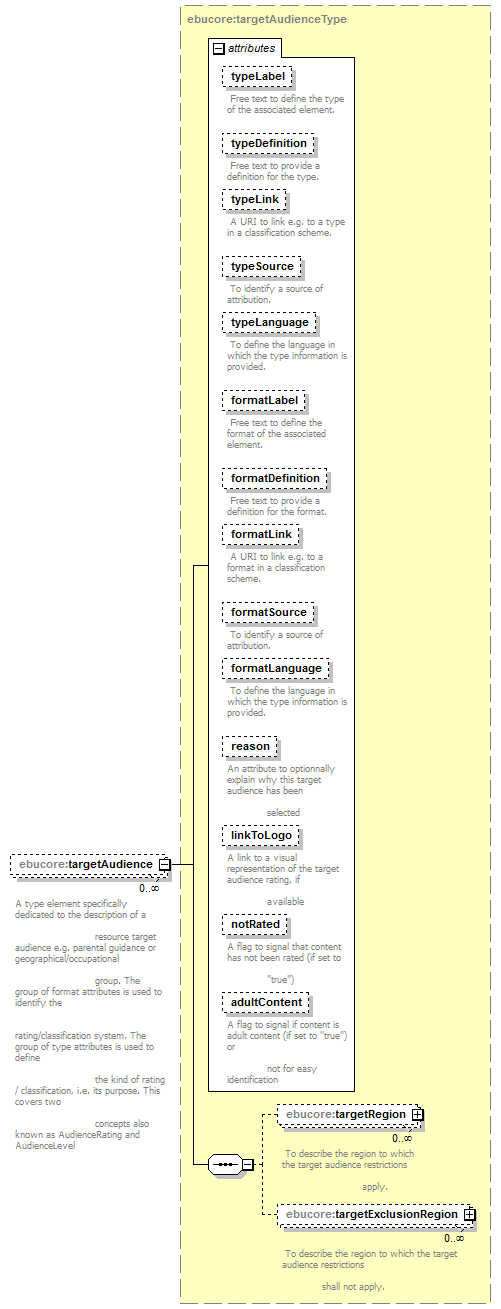| diagram |  |
||||||||||||||||||||||||||||||||||||||||||||||||||||||
| namespace | urn:ebu:metadata-schema:ebuCore_2014 | ||||||||||||||||||||||||||||||||||||||||||||||||||||||
| children | type ebucore:genre ebucore:objectType ebucore:targetAudience | ||||||||||||||||||||||||||||||||||||||||||||||||||||||
| used by |
|
||||||||||||||||||||||||||||||||||||||||||||||||||||||
| attributes |
|
||||||||||||||||||||||||||||||||||||||||||||||||||||||
| annotation |
|
||||||||||||||||||||||||||||||||||||||||||||||||||||||
| source | <xs:complexType name="typeType"> <xs:annotation> <xs:documentation>The nature or genre of the content of the resource. Type includes terms describing general categories, functions, genres, or aggregation levels for content. Recommended best practice is to select a value from a controlled vocabulary. To describe the physical or digital manifestation of the resource, use the FORMAT element. </xs:documentation> </xs:annotation> <xs:sequence> <xs:element ref="dc:type" minOccurs="0" maxOccurs="unbounded"> <xs:annotation> <xs:documentation> The EBU core metadata set is built as a refinement of the Dublin Core. </xs:documentation> </xs:annotation> </xs:element> <xs:element name="genre" minOccurs="0" maxOccurs="unbounded"> <xs:annotation> <xs:documentation>A type element specifically dedicated to the description of a resource genre</xs:documentation> </xs:annotation> <xs:complexType> <xs:attributeGroup ref="ebucore:typeGroup"> <xs:annotation> <xs:documentation>To define the Type reference data.</xs:documentation> </xs:annotation> </xs:attributeGroup> </xs:complexType> </xs:element> <xs:element name="objectType" minOccurs="0" maxOccurs="unbounded"> <xs:annotation> <xs:documentation>A type element specifically dedicated to the description of type of resource being describe e.g. programme, item, episode, series, record</xs:documentation> </xs:annotation> <xs:complexType> <xs:attributeGroup ref="ebucore:typeGroup"> <xs:annotation> <xs:documentation>To define the Type reference data.</xs:documentation> </xs:annotation> </xs:attributeGroup> </xs:complexType> </xs:element> <xs:element name="targetAudience" type="ebucore:targetAudienceType" minOccurs="0" maxOccurs="unbounded"> <xs:annotation> <xs:documentation>A type element specifically dedicated to the description of a resource target audience e.g. parental guidance or geographical/occupational group. The group of format attributes is used to identify the rating/classification system. The group of type attributes is used to define the kind of rating / classification, i.e. its purpose. This covers two concepts also known as AudienceRating and AudienceLevel</xs:documentation> </xs:annotation> </xs:element> </xs:sequence> <xs:attributeGroup ref="ebucore:typeGroup"> <xs:annotation> <xs:documentation> To allow defining a type of dc:type other than 'genre', 'objectType', or 'targetAudience'. </xs:documentation> </xs:annotation> </xs:attributeGroup> <xs:attribute name="note" type="string"> <xs:annotation> <xs:documentation> Optional additional contextual information. </xs:documentation> </xs:annotation> </xs:attribute> </xs:complexType> |
attribute typeType/@note
| type | xs:string | ||
| annotation |
|
||
| source | <xs:attribute name="note" type="string"> <xs:annotation> <xs:documentation> Optional additional contextual information. </xs:documentation> </xs:annotation> </xs:attribute> |
element typeType/genre
| diagram |  |
||||||||||||||||||||||||||||||||||||||||||||||
| namespace | urn:ebu:metadata-schema:ebuCore_2014 | ||||||||||||||||||||||||||||||||||||||||||||||
| properties |
|
||||||||||||||||||||||||||||||||||||||||||||||
| attributes |
|
||||||||||||||||||||||||||||||||||||||||||||||
| annotation |
|
||||||||||||||||||||||||||||||||||||||||||||||
| source | <xs:element name="genre" minOccurs="0" maxOccurs="unbounded"> <xs:annotation> <xs:documentation>A type element specifically dedicated to the description of a resource genre</xs:documentation> </xs:annotation> <xs:complexType> <xs:attributeGroup ref="ebucore:typeGroup"> <xs:annotation> <xs:documentation>To define the Type reference data.</xs:documentation> </xs:annotation> </xs:attributeGroup> </xs:complexType> </xs:element> |
element typeType/objectType
| diagram |  |
||||||||||||||||||||||||||||||||||||||||||||||
| namespace | urn:ebu:metadata-schema:ebuCore_2014 | ||||||||||||||||||||||||||||||||||||||||||||||
| properties |
|
||||||||||||||||||||||||||||||||||||||||||||||
| attributes |
|
||||||||||||||||||||||||||||||||||||||||||||||
| annotation |
|
||||||||||||||||||||||||||||||||||||||||||||||
| source | <xs:element name="objectType" minOccurs="0" maxOccurs="unbounded"> <xs:annotation> <xs:documentation>A type element specifically dedicated to the description of type of resource being describe e.g. programme, item, episode, series, record</xs:documentation> </xs:annotation> <xs:complexType> <xs:attributeGroup ref="ebucore:typeGroup"> <xs:annotation> <xs:documentation>To define the Type reference data.</xs:documentation> </xs:annotation> </xs:attributeGroup> </xs:complexType> </xs:element> |
element typeType/targetAudience
| diagram |  |
||||||||||||||||||||||||||||||||||||||||||||||||||||||||||||||||||||||||||||||||||||||||||||||||||||||||||||||||||||||
| namespace | urn:ebu:metadata-schema:ebuCore_2014 | ||||||||||||||||||||||||||||||||||||||||||||||||||||||||||||||||||||||||||||||||||||||||||||||||||||||||||||||||||||||
| type | ebucore:targetAudienceType | ||||||||||||||||||||||||||||||||||||||||||||||||||||||||||||||||||||||||||||||||||||||||||||||||||||||||||||||||||||||
| properties |
|
||||||||||||||||||||||||||||||||||||||||||||||||||||||||||||||||||||||||||||||||||||||||||||||||||||||||||||||||||||||
| children | ebucore:targetRegion ebucore:targetExclusionRegion | ||||||||||||||||||||||||||||||||||||||||||||||||||||||||||||||||||||||||||||||||||||||||||||||||||||||||||||||||||||||
| attributes |
|
||||||||||||||||||||||||||||||||||||||||||||||||||||||||||||||||||||||||||||||||||||||||||||||||||||||||||||||||||||||
| annotation |
|
||||||||||||||||||||||||||||||||||||||||||||||||||||||||||||||||||||||||||||||||||||||||||||||||||||||||||||||||||||||
| source | <xs:element name="targetAudience" type="ebucore:targetAudienceType" minOccurs="0" maxOccurs="unbounded"> <xs:annotation> <xs:documentation>A type element specifically dedicated to the description of a resource target audience e.g. parental guidance or geographical/occupational group. The group of format attributes is used to identify the rating/classification system. The group of type attributes is used to define the kind of rating / classification, i.e. its purpose. This covers two concepts also known as AudienceRating and AudienceLevel</xs:documentation> </xs:annotation> </xs:element> |
XML Schema documentation generated by XMLSpy Schema Editor http://www.altova.com/xmlspy